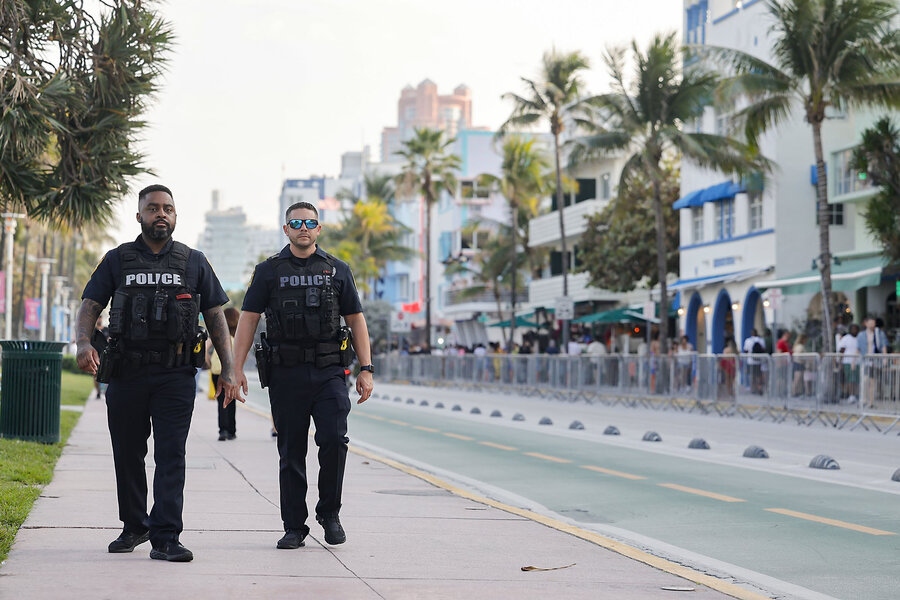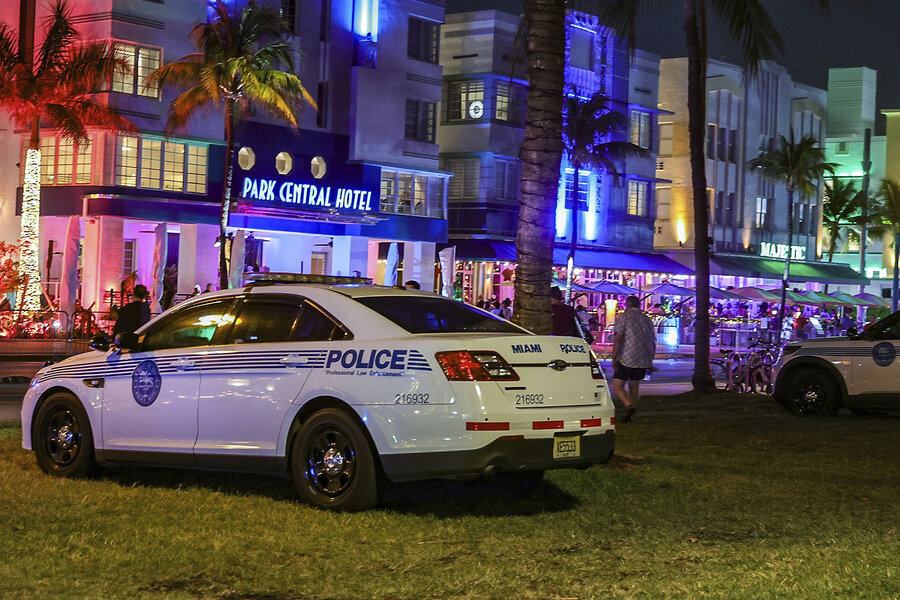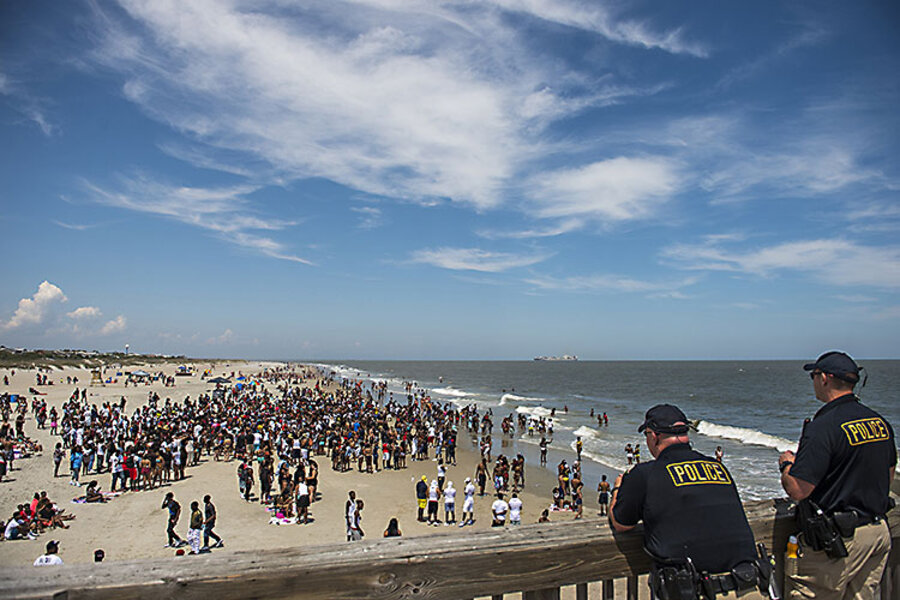Spring ‘breakup’: What’s behind the US beach town crackdown
Loading...
| Tybee Island, Ga.
A year after Miami police lost control of spring break crowds on the city’s Ocean Drive, the annual fun-in-the-sun rite of college students has darkened into a new focus on law and order that stretches far beyond Magic City.
As Miami rolls out curfews and bag checks, other places from the Florida Keys to Tybee Island, Georgia, are also imposing tougher policies or expanded policing.
Why We Wrote This
A story focused onAn influx of partying college students floods Southern beaches every spring break. This year, Miami and other destinations are pushing back. Racial tensions and year-round residents seeking quiet are two of the undercurrents at work.
The move comes after a chaotic 2023 spring break, which saw two deadly shootings and 488 arrests – half of them felony offenses – in Miami alone.
Beyond the disruption of rowdy outsiders that tourist hot spots have always had to tolerate, Miami and others may still be in heightened, post-pandemic caution mode. But the fact that many of the Miami spring breakers were Black, critics say, also shows how responses by local authorities and the media can hinge on who attends.
“If you already see us as a threat, and you’ve made it clear that we’re not welcome here, that puts a chip on someone’s shoulder, quite naturally,” says Andrew Kahrl, a beach access expert and a professor of African American studies at the University of Virginia. “These kinds of measures ultimately backfire.”
A year after Miami police lost control of spring break crowds on the city’s Ocean Drive, the annual fun-in-the-sun rite of college students has darkened into a new focus on law and order that stretches far beyond Magic City.
Miami’s advertisement-led campaign to “break up with spring break” has included $100 parking fees, curfews, bag checks, DUI checkpoints, and police officers on every corner.
The move comes after a chaotic 2023 spring break, which saw two deadly shootings and 488 arrests – half of them felony offenses, according to Miami Beach Police. More than 100 firearms were seized. Scenes of the Ocean Drive mayhem appeared on national news shows. The city called a state of emergency.
Why We Wrote This
A story focused onAn influx of partying college students floods Southern beaches every spring break. This year, Miami and other destinations are pushing back. Racial tensions and year-round residents seeking quiet are two of the undercurrents at work.
Beyond the disruption of rowdy outsiders that tourist hot spots have always had to tolerate, Miami and others may still be in heightened, post-pandemic caution mode. But the fact that many of the Miami spring breakers were Black, critics say, also shows how responses by local authorities and the media can hinge on who attends.
The crackdowns, rooted in the cycle of wear-and-tear borne by sleepy beachside towns, sometimes reveal more about the host towns than about the hordes of incoming guests.
Many factors have come into play with this spring break breakup.
Most COVID-19 warnings have now been modified, if not lifted. But many year-round beach town residents are retirees, wary of hypersocial and boisterous college students.
Race isn’t always a driving factor behind shifting policies. Panama City Beach, Florida, whose spring break college crowd is primarily white, also has new rules and stepped-up enforcement.
Other Florida communities with new safety efforts range from Destin (a “zero-tolerance” policy for law-breaking behavior) to Key West (extra mounted patrols) to New Smyrna Beach (a new curfew).
Gov. Ron DeSantis last week announced that state troopers will assist 17 communities that have asked for help. Behavior that may be acceptable elsewhere, he said, “is not going to fly in the Sunshine State.”
But amid such toughening of police posture, these coastal conflicts put a spotlight on a U.S. beach town history often fraught with class and racial tensions, eager for tourism income yet wary of disruption.
From Miami to Tybee Island, Georgia, race complicates the management of the good times. Many U.S. beach towns have been the sites of wade-in protests and battles over property rights, public safety, and the more profound notion of the public trust doctrine, which guarantees that “no one ... is forbidden to approach the seashore.”
That means that amid shifting desires by young people for travel and fun, seaside communities often have to confront their own histories and how those arc forward.
“You get democracy in action,” says John Laurie, who wrote his college dissertation at the University of New Orleans on the host-guest dynamics of the U.S. spring break season. “At a certain point, people have to decide, what do I want my city to emphasize or be like? That’s when action happens.”
Stepped-up law enforcement in Miami – where Black people have been fighting for beach access since the 1940s – is nothing new.
In the 1980s, Time magazine dubbed the Florida city “Paradise Lost” given its reputation for violence, some of it tied to spring break antics. In 1985, Fort Lauderdale saw over a quarter million students pack the beaches, leading to new laws against public drinking and using balconies to jump into pools.
According to global tourism expert Jungho Suh, such reactions are important because travel serves as a means of exchanging culture, ideas, and economic value.
“It is understandable to implement such measures this year because of all the horrific cases that happened in the past year,” says Dr. Suh, who teaches at George Washington University’s School of Business. But policymakers “have to think about their brand or authenticity from a long-term perspective. ... The community could lose its identity.”
Here, an annual spring break pilgrimage by Black college students to Tybee Island, called Orange Crush, went off the rails last year. There was a shooting, stampedes through sensitive dune areas, and a massive traffic jam that shut down the island’s two-lane causeway, preventing access for emergency vehicles. After a long and unsuccessful effort by the island council to bar future Orange Crush gatherings, Georgia lawmakers passed a bill earlier this year that allows the council to sue online promoters for unpermitted events. Tybee Mayor Brian West hopes that the new law will help end the party.
“There were drug overdoses; people were passed out ... on the beach in the dark; police ran out of Narcan to save lives,” says Mayor West. “Police weren’t quite sure how to handle it. It was completely unacceptable what was happening.”
But critics say what islanders deem unacceptable sometimes has to do with the color of revelers’ skin. For some, the search for fun may also double as a sort of resistance movement to the white control of beaches that once belonged to the diaspora of enslaved Black people.
In a state where 1 in 4 residents are Black, 94% of Tybee Island’s residents identify as white. The first brochures advertising a new late 19th-century resort here described its potential as a “white” beach. It was also an early site of the 1950s and ’60s wade-ins, when demonstrators demanded equal access by stepping into whites-only waters.
To be sure, race relations have improved here as in the rest of the South. In recent years, the island has added new markers to document the history of civil rights era wade-ins and promoted a walking tour featuring contributions of Black residents to the island’s history and culture.
Nevertheless, Julia Pearce, head of the Tybee MLK Human Rights Organization, points to the history of Tybee’s tense relationship with Orange Crush.
She cites a study by Georgia Southern University Professor Amy Potter that calls the spring break crackdowns “boundary transgressions,” where laws and customs put in place by white officials unnecessarily restrict Black people’s mobility. Portrayals of mayhem by authorities sometimes clash with reports from Black beachgoers, including one who described Orange Crush to researchers as “the epitome of Black culture – carefree and fun.”
The U.S. Department of Justice has chided the city for trying to set up alcohol-free zones around the Orange Crush event while allowing alcohol for the Fourth of July, a mostly white beach gathering that in the past has created comparable numbers of arrests and cleanup costs.
Mayor West says the long-running Orange Crush concerns are primarily about public safety.
As in Miami and other beach towns across the United States, this year’s Orange Crush on Tybee Island will be dominated by law enforcement – and a new traffic plan.
Such measures can be effective, at least at discouraging major disruptions. So far, spring break in Miami has been far quieter than in the past two years. But cities also run the risk of exacerbating tensions by withdrawing the welcome mat.
At the end of the day, many beach towns bring these problems on themselves, given marketing that features visitors enjoying the beach, often with drink in hand. So when certain visitors feel unwelcome upon arrival, that can increase hostility and create a downward spiral.
“If you already see us as a threat, and you’ve made it clear that we’re not welcome here, that puts a chip on someone’s shoulder, quite naturally,” says Andrew Kahrl, a beach access expert and a professor of African American studies at the University of Virginia, in Charlottesville. “These kinds of measures ultimately backfire.”










